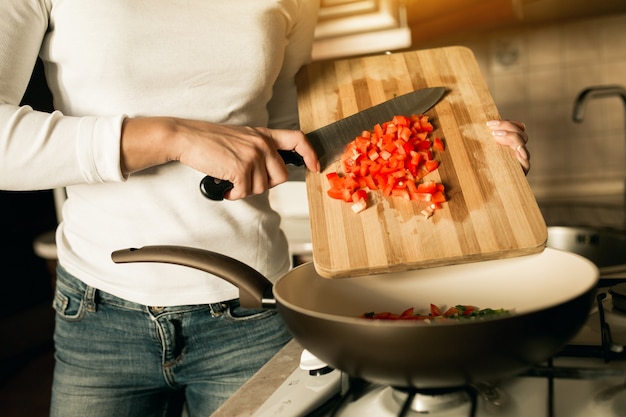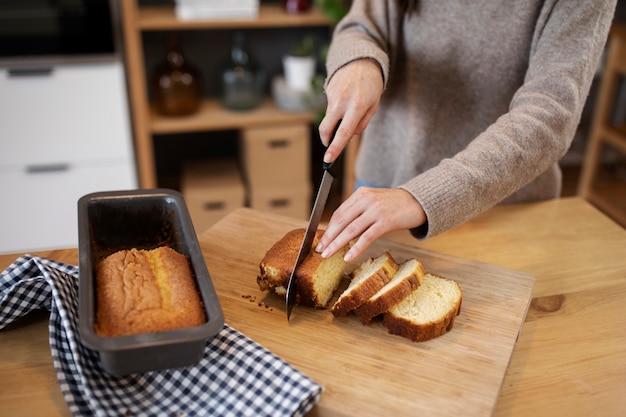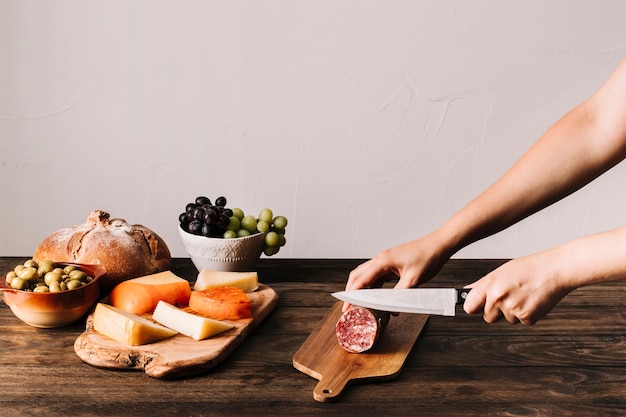Ah, ham! It's a classic, isn't it? Whether it's a centerpiece for a holiday feast or a simple weeknight dinner, a good ham always hits the spot. But sometimes, figuring out the right cooking time can feel like a bit of a head-scratcher. Don't worry, fellow food lovers! I'm here to help you navigate the world of oven ham cooking and achieve delicious results every single time.
Part 1: Setting the Stage – Understanding the Different types of ham

First things first, let's talk about the different types of ham you might encounter. They each have their own quirks, which is something to keep in mind as you plan your culinary adventure.
1.1 whole ham – The Granddaddy of Them All
This is the king of hams, the whole shebang. It's usually bone-in, and it can be quite a hefty piece to tackle. Think of it as a culinary challenge – the kind that rewards you with a mountain of delicious ham.
1.2 half ham – A More Manageable Size
Imagine a whole ham, but cut in half. You've got a half ham! It's a great option for smaller gatherings, and it's often available bone-in or boneless.
1.3 spiral-sliced ham – The Deli Counter Star
This is the ham you usually see pre-sliced in the deli counter. It's super convenient, as it's ready to be sliced and served. It's generally boneless and often comes with a glaze already on it. Think of it as a shortcut to deliciousness.
Part 2: The Key Players – Weight and Temperature

Now, let's get into the nitty-gritty. Two crucial factors will determine how long you cook your ham: its weight and the oven temperature.
2.1 Weight – Bigger Ham, Longer Cook Time
It's common sense, really: the bigger the ham, the longer it needs to cook. A general rule of thumb is to allow 15-20 minutes of cooking time per pound of ham. So, a 10-pound ham will take roughly 2.5 to 3 hours to cook through.
2.2 Oven Temperature – The Heat Factor
The temperature you bake your ham at also plays a big part. Most recipes recommend cooking ham at 325°F (160°C). This temperature ensures even cooking and prevents the ham from drying out. Think of it as finding that sweet spot for perfect ham.
Part 3: Oven ham cooking guide – Step-by-Step Instructions

Alright, let's get into the action! Here's a detailed guide to cooking different types of ham in the oven:
3.1 Bone-in Whole or Half Ham – A Classic Approach
- Preheat your oven to 325°F (160°C). This is the standard temperature for ensuring even cooking.
- Place the ham in a roasting pan. If your ham has a skin, you can score it with a sharp knife to allow the fat to render. This helps add flavor and prevents the ham from becoming too dry.
- Add about 1 cup of water to the bottom of the pan. This creates a moist environment for cooking and helps prevent the ham from drying out. Think of it as a little steam bath for your ham.
- Cook for 15-20 minutes per pound. Keep in mind that this is just a guideline; always check the internal temperature to be sure.
- Check the internal temperature with a meat thermometer. For safe eating, the ham should reach an internal temperature of 145°F (63°C). Don't be afraid to check the temperature multiple times to ensure your ham is cooked to perfection.
- Let the ham rest for 15-20 minutes before slicing and serving. This allows the juices to redistribute, resulting in a juicier, more flavorful ham. Think of it as a little post-workout rest for your ham.
3.2 Spiral-Sliced Ham – The Easy and Delicious Option
Spiral-sliced ham is a dream to cook. It's already pre-sliced, making it super easy to serve. Here's what you need to do:
- Preheat your oven to 325°F (160°C). This is our standard temperature, remember?
- Place the ham in a roasting pan. If it's already glazed, you can leave it as is. If it's not, you can apply a glaze of your choice. Glazes add a burst of flavor and a beautiful shine to your ham.
- Cook for 15-20 minutes per pound. Always check the internal temperature with a meat thermometer to be sure.
- Check the internal temperature with a meat thermometer. It should reach 140°F (60°C) for spiral-sliced ham.
- Let the ham rest for 10-15 minutes before slicing and serving. This gives the juices a chance to redistribute for a tastier ham.
3.3 Cooking Times for Different Ham Sizes – A Handy Guide
To make things even clearer, here's a table summarizing typical cooking times for different ham sizes:
| Ham Size (pounds) | Approximate Cooking Time (minutes) |
|---|---|
| 5-7 pounds | 75-105 minutes |
| 8-10 pounds | 120-150 minutes |
| 11-13 pounds | 165-195 minutes |
| 14-16 pounds | 210-240 minutes |
Remember, this is just a guideline. Always check the internal temperature of your ham to ensure it's cooked to the right temperature.
Part 4: Glazing for an Extra Touch of Flavor – Elevate Your Ham Game
A good glaze can really elevate a ham to the next level. It's like adding a final flourish to a masterpiece. There are endless possibilities, but here are a few classic glazes to get you started:
4.1 brown sugar glaze – A Sweet and Simple Classic
This glaze is super easy to make, and it adds a lovely sweetness to your ham.
- Combine 1 cup of brown sugar, 1/4 cup of honey, and 2 tablespoons of Dijon mustard in a small saucepan. The mustard adds a little tanginess to balance out the sweetness.
- Bring the mixture to a simmer over medium heat. This helps the ingredients meld together and create a beautiful, glossy glaze.
- Cook for about 5 minutes, or until the glaze has thickened slightly. You want it to be thick enough to coat the ham but not too thick to become sticky.
- Brush the glaze over the ham during the last 30 minutes of cooking. This gives the glaze a chance to caramelize and create a beautiful, crusty finish.
4.2 pineapple glaze – Sweet, Tangy, and Tropical
This glaze adds a touch of sweetness and tanginess to your ham, with a hint of tropical flair.
- Combine 1 cup of pineapple juice, 1/2 cup of brown sugar, and 1/4 cup of soy sauce in a small saucepan. The soy sauce adds a savory element to balance out the sweetness of the pineapple juice and brown sugar.
- Bring the mixture to a simmer over medium heat. This helps the ingredients blend together beautifully.
- Cook for about 5 minutes, or until the glaze has thickened slightly. You want it to be thick enough to coat the ham but not too thick to become sticky.
- Brush the glaze over the ham during the last 30 minutes of cooking. This gives the glaze a chance to caramelize and create a stunning, glossy finish.
4.3 honey mustard glaze – Sweet, Tangy, and Savory
This glaze offers a delicious combination of sweet and tangy flavors, with a hint of mustard spice.
- Combine 1/2 cup of honey, 1/4 cup of Dijon mustard, and 2 tablespoons of soy sauce in a small saucepan. The soy sauce adds a savory element to balance out the sweetness of the honey and the tanginess of the mustard.
- Bring the mixture to a simmer over medium heat. This helps the ingredients meld together perfectly.
- Cook for about 5 minutes, or until the glaze has thickened slightly. You want it to be thick enough to coat the ham but not too thick to become sticky.
- Brush the glaze over the ham during the last 30 minutes of cooking. This gives the glaze a chance to caramelize and create a beautiful, glossy finish.
These are just a few ideas to get you started. Feel free to experiment with different flavors and ingredients. You can add things like ginger, garlic, citrus zest, or even a splash of rum to your glaze. Let your culinary creativity run wild!
Part 5: Serving and Storage – The Finishing Touches
You've cooked your ham to perfection. Now, it's time to enjoy it! But before you dive in, let's talk about serving and storage.
5.1 Serving – The Star of the Show
Your delicious ham is ready to take center stage. You can serve it warm or at room temperature, depending on your preference. It's a versatile centerpiece, perfect for a variety of side dishes, like mashed potatoes, roasted vegetables, or a simple salad. And don't forget the bread and butter!
5.2 Storage – Keeping It Fresh and Delicious
If you have any leftover ham, it's important to store it properly to keep it fresh and flavorful.
- Refrigerate leftover ham in an airtight container for up to 3-4 days. This helps prevent it from drying out and absorbing other flavors in your refrigerator.
- You can also freeze leftover ham for up to 2 months. Just wrap it tightly in plastic wrap and then in aluminum foil. This helps prevent freezer burn and preserves the flavor.
- When ready to use frozen ham, thaw it in the refrigerator overnight. Then, reheat it in the oven or microwave.
Part 6: FAQs – Addressing Your Burning Questions
Now, let's address any lingering questions you might have about cooking ham in the oven.
6.1 What if my ham is already cooked?
If your ham is already cooked, you don't need to cook it for the full time. Just reheat it in the oven at 325°F (160°C) for about 15-20 minutes per pound, or until it's heated through. Remember, you're just warming it up, not cooking it from scratch!
6.2 Can I cook ham in a slow cooker?
Absolutely! Slow cookers are fantastic for cooking ham, especially if you want a super tender result. Just place your ham in the slow cooker, add about 1 cup of water or broth, and cook on low for 6-8 hours, or until the internal temperature reaches 140°F (60°C).
6.3 What if my ham is too salty?
If your ham is a bit too salty, you can try soaking it in cold water for a few hours before cooking. This can help draw out some of the salt. However, be aware that soaking can also affect the texture of the ham. You may need to adjust the cooking time slightly as a result.
6.4 Can I cook ham in a pressure cooker?
Yes, pressure cookers can be used to cook ham quickly. However, cooking times will vary depending on the pressure cooker and the size of the ham. Always refer to the pressure cooker manual for specific instructions.
6.5 How can I tell if my ham is done?
The best way to determine if your ham is done is to use a meat thermometer. It should reach an internal temperature of 140°F (60°C) for spiral-sliced ham, or 145°F (63°C) for bone-in ham. You can also check for doneness by inserting a fork into the thickest part of the ham. If the juices run clear, it's cooked through.
Part 7: A Few Final Thoughts – Mastering the Art of Oven Ham
Cooking ham in the oven is truly a breeze, and it always impresses. Just remember to keep an eye on the cooking time, check the internal temperature, and don't be afraid to experiment with different glazes. With a little practice, you'll be a ham-cooking pro in no time! And who knows, you might even become the go-to ham master in your household.
Everyone is watching

How to Cook Frozen Lobster Tails Perfectly: A Step-by-Step Guide
RecipesLobster. Just the word conjures up images of lavish meals, special occasions, and a taste of luxury. But let's...

Pigs in a Blanket Cooking Time: How Long to Bake for Perfect Results
RecipesAh, pigs in a blanket. Just the name conjures up images of those delightful little parcels of crispy pastry en...

Pork Fillet Cooking Time: How Long to Cook It Perfectly
RecipesPork fillet, or tenderloin as it's sometimes called, is a real favourite in our house. It's so versatile, and...

The Ultimate Guide to Tender, Juicy Pulled Pork
RecipesRight, let's talk pulled pork. It's one of those dishes that just screams "comfort food," doesn't it? I mean...

The Ultimate Guide to Cooking Delicious Frankfurters
RecipesLet's face it, we all love a good frankfurter. It's a classic, simple, and always satisfying. But let's be rea...
